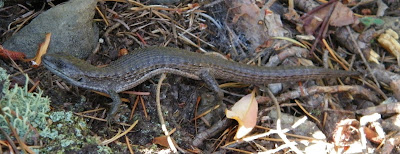I watched an osprey eating a fish in Discovery Park. As it ripped at the flesh, a variety of birds came by and perched on the same dead treetop. A pair of northern flickers, a goldfinch, some house finches and an Anna's hummingbird came and went, and the osprey went on eating, although it did look up when the hummingbird buzzed a foot from its face.

But when a pair of crows arrived, I thought that meant trouble for the osprey. All the crows would have to do was caw a certain way, and every crow in the neighborhood would swoop in for a mob attack on the osprey. Whenever I've seen crows encounter a lone raptor, that's what happens. But not this time.

Turns out that eating a fish while perched on a tree is a little messy, and the osprey was dropping fish bits as it went.
The crows watched the osprey as it ate.
Every so often the larger of the two would swoop below, pick up a fallen scrap of fish and eat it. Once the crow passed bits to its smaller companion.

You can hardly see it in the photo, but this crow is eating what looked like a bit of fish guts.

When only the tail was left, the crows moved on.

I can see how staying quiet around the feeding osprey gave an advantage to the pair of crows, even though they only ate scraps. After all, if the crows called in a gang, and if that that gang managed to seize the fish, the most those two could hope for is a portion of the fish.
This way they don't have to share the fish they find, they don't risk getting hurt by a big dangerous bird and, because they didn't hassle the osprey, it might let them approach and bum another meal in future.















































